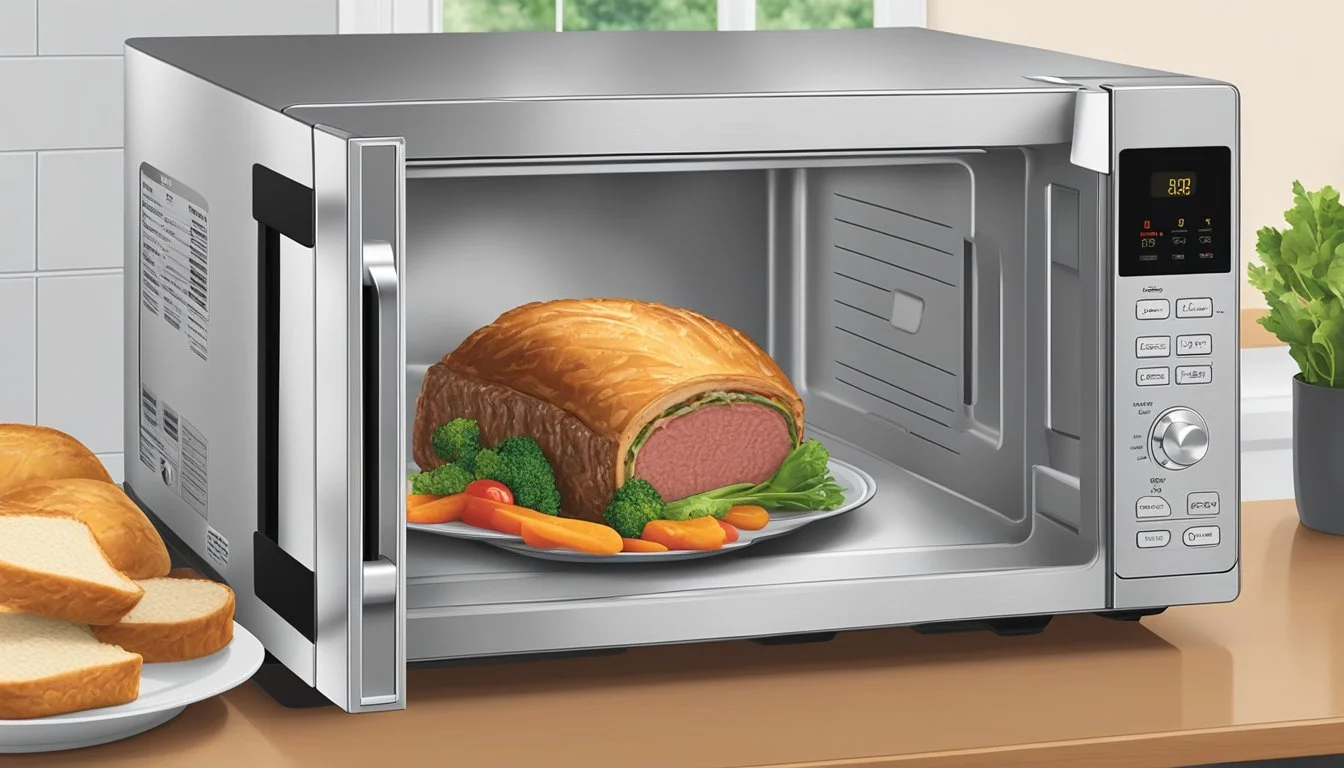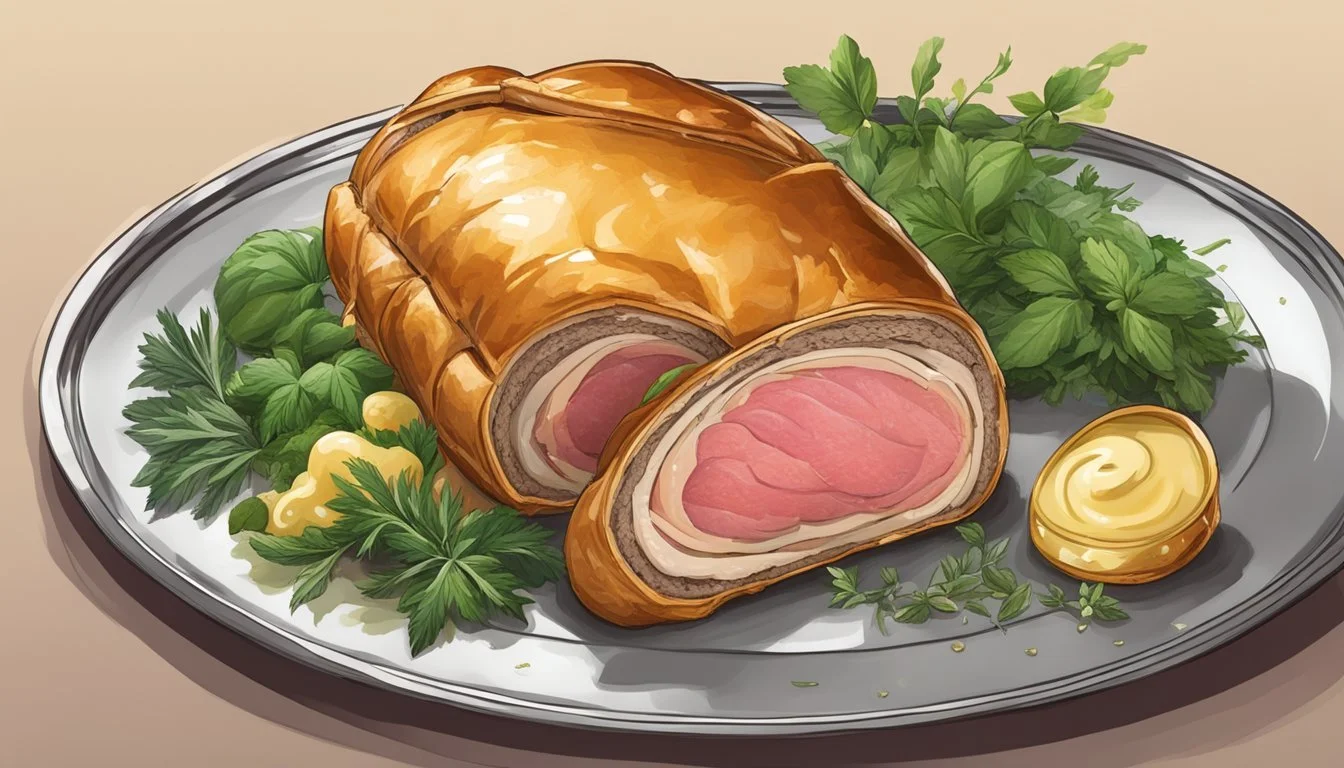How to Reheat Aldi's Specially Selected Beef Wellington
A Step-by-Step Guide
Aldi's Specially Selected Beef Wellington is a gourmet treat that brings the elegance of fine dining right to your kitchen. Properly reheating this delicacy is essential to maintain its juicy, tender meat and flaky pastry crust. To reheat Aldi's Specially Selected Beef Wellington, preheat your oven to 250°F and gently warm the dish for 20-25 minutes, ensuring it reaches an internal temperature of at least 165°F.
For an even crispier crust, consider placing the Beef Wellington on a wire rack set over a baking sheet. This allows the hot air to circulate evenly, preventing a soggy bottom. Microwaving is also an option for speed, but it may soften the pastry. For the best results, use the oven method.
Ease of preparation makes Aldi's Specially Selected Beef Wellington accessible even to those who aren't gourmet chefs. These tips ensure you enjoy it as if freshly made, preserving both its flavor and texture.
Overview of Beef Wellington
Beef Wellington is a classic dish renowned for its elegant presentation and exquisite flavor. It typically features a tender beef tenderloin encased in a puff pastry crust. The beef is first seared to lock in juices and develop a rich exterior.
A key component is the mushroom duxelle, a finely chopped mixture of mushrooms, shallots, and herbs cooked until moisture evaporates. This mixture provides a flavorful layer that complements the tenderloin.
Prosciutto is often wrapped around the beef and mushroom duxelle for added flavor and to help keep the moisture of the beef intact during baking. This layer also adds a touch of savory saltiness.
The entire assembly is then enveloped in puff pastry, which creates a crispy, golden-brown exterior when baked. The combination of tender beef, savory mushrooms, and crisp pastry results in a rich, flavorful dish.
Here's a quick look at the components:
Component Role Beef Tenderloin Main protein, center of the dish Mushroom Duxelle Savory, moisture-absorbing layer Prosciutto Adds saltiness and retains moisture Puff Pastry Crispy, flaky outer layer
Beef Wellington is perfect for special occasions or a luxurious meal at home. Each layer adds depth and complexity, making every bite a celebration of textures and tastes.
Preparation Before Reheating
Proper preparation is crucial before reheating Aldi's Specially Selected Beef Wellington. This helps achieve an evenly warmed dish without compromising its texture or flavor.
Thawing the Beef Wellington
If your Beef Wellington is frozen, it needs to be properly thawed. For best results, place it in the refrigerator for at least 24 hours. This gradual thawing process helps retain moisture and flavor.
Avoid thawing at room temperature as it may cause uneven thawing. Ensure any accompanying sauces or garnishes are thawed separately, if applicable. Using a meat thermometer can help ensure the meat is fully thawed before reheating. It should read around 40°F (4°C) in the center. Pat the exterior with paper towels to remove excess moisture. This prevents sogginess during reheating.
Preheating the Oven
An evenly preheated oven ensures that the Beef Wellington warms through without drying out. Preheat the oven to 250°F (120°C) if the dish is already thawed. For freshly thawed or chilled Beef Wellington, maintain this gentle temperature to avoid overcooking the pastry.
Place a baking sheet with a wire rack to allow even heat distribution. Cover the Beef Wellington with aluminum foil to lock in moisture. It's beneficial to use an oven thermometer to monitor the internal temperature. Aim for an internal temperature of 130°F (54°C) for a medium-rare finish. If a crispy crust is desired, remove the foil in the final 5-7 minutes.
Reheating in the Oven
To reheat Aldi's Specially Selected Beef Wellington in the oven, first preheat the oven to 250°F if it is not frozen, or 400°F if it is frozen.
Line a baking tray or sheet with parchment paper. Then, place the beef Wellington on the tray. Cover the dish loosely with aluminum foil to help retain moisture and heat evenly.
If the Wellington is frozen, cook at 400°F for 15 minutes, then reduce the temperature to 250°F for the remaining time.
For a Wellington that is not frozen, bake at 250°F for about 20-25 minutes, or until it reaches the desired internal temperature.
Utilize an oven thermometer to monitor the internal temperatures aiming for 130°F for medium-rare or 140°F for medium.
Keep in mind that reheating may affect the crispness of the pastry. To keep it crispy, try removing the foil for the last 5 minutes of baking.
Reheated Beef Wellington Internal Temperature Guide:
Doneness Temperature Medium-rare 130°F (54°C) Medium 140°F (60°C)
To enhance the pastry's appearance, consider brushing an egg wash over it before the final minutes of baking. This helps restore its golden-brown color.
Place the Wellington on the middle shelf of the oven to ensure even reheating.
Carefully monitor and adjust the temperature as needed to achieve the best result.
Alternative Reheating Methods
Reheating Aldi's Specially Selected Beef Wellington requires a careful approach to maintain its moisture and rich flavors. Consider the following methods to achieve the best results.
Microwave Instructions
The microwave provides a quick option for reheating. First, slice the Beef Wellington into individual portions to ensure even heating. Place the slices on a microwave-safe plate, and cover them with a damp paper towel to retain moisture.
Set the microwave to a medium setting (50-70% power) and heat for 2 minutes. Check the temperature and continue in 30-second intervals until warmed through. Avoid using high power as it can dry out the beef and affect the texture of the pastry.
If available, a microwave-safe cover can help maintain the steam and keep the pastry from getting tough.
Stovetop Techniques
Using the stovetop offers another way to reheat while preserving the dish’s quality. Preheat a nonstick skillet over medium-low heat. Add a small amount of beef stock or water to the pan to keep the Beef Wellington moist during reheating.
Place the slices in the skillet, cover with a lid, and heat for about 5 minutes per side. Monitor closely to avoid overcooking the beef.
For added flavor, an optional step is to warm a small amount of sauce separately and drizzle over the slices before serving. If necessary, cover the skillet with a tight layer of aluminum foil to trap steam and prevent drying out.
By following these methods, you can enjoy your Beef Wellington with its original taste and texture preserved.
Serving and Presentation
Serving Aldi's Specially Selected Beef Wellington requires attention to detail to highlight its flavors and textures. Ensure the flaky pastry remains crisp by not covering it while serving.
Serving Temperature:
The ideal serving temperature for Beef Wellington is warm but not hot. Using a meat thermometer, the internal temperature should be about 130°F (54°C).
Presentation:
Place the Beef Wellington on a large, flat, warm plate. This allows space for sides and garnishes.
Use a sharp knife to slice the Wellington, ensuring clean cuts that reveal the layers of beef and mushroom duxelles.
Sauce:
Red wine sauce is an excellent choice. Drizzle it around the plate or serve it in a small sauce boat.
Avoid pouring the sauce directly on the puff pastry to maintain its crispiness.
Accompaniments:
Serve with creamy mashed potatoes beside the Beef Wellington to complement the rich flavors.
Asparagus spears add color and a fresh, crisp texture. Steam or sauté them lightly.
A small sprig of fresh herbs like thyme or rosemary can enhance the visual appeal and aroma.
Careful consideration of these elements ensures that the presentation of Aldi's Specially Selected Beef Wellington is as delightful as its taste.
Safety and Storage Tips
When handling Aldi's Specially Selected Beef Wellington, proper storage and reheating are crucial to maintaining its quality and ensuring food safety. Follow these guidelines to maximize shelf life and prevent any health risks.
Storing Leftovers
Refrigerate leftover beef wellington within two hours of serving. Use an airtight container to retain moisture and flavor.
Shelf Life:
In the refrigerator: 3-4 days
At room temperature: 2 hours
Ensure the refrigerator is set at 40°F (4°C) to slow bacterial growth. Avoid leaving the beef wellington uncovered, as it can dry out and absorb other odors.
Freezing and Defrosting Instructions
Freeze beef wellington if you need to store it longer than a few days. Wrap the wellington tightly in plastic wrap and follow with a layer of aluminum foil.
Freezing Tips:
Label the package with the date
Store at 0°F (-18°C)
Defrosting:
Move the beef wellington to the refrigerator and allow it to thaw for 24 hours. Avoid defrosting at room temperature to prevent bacterial growth. For quicker defrosting, use the defrost setting on a microwave, following manufacturer instructions.
Understanding Beef Wellington
Beef Wellington is a classic British dish renowned for its exceptional taste and luxurious components. Aldi's Specially Selected Beef Wellington brings this fine dining experience into your home with carefully sourced British beef and high-quality ingredients.
Nutritional Values
Beef Wellington is a rich and indulgent meal. It typically includes beef tenderloin wrapped in prosciutto, mushroom duxelles, and puff pastry. A single serving can be quite caloric with a significant amount of protein and fat.
An average portion provides around 400-500 calories, 30g of protein, and 20-30g of fat. It also contains essential vitamins and minerals such as iron, zinc, and B vitamins from the beef, and fiber from the mushroom duxelles.
Origin and Production
The origins of Beef Wellington are somewhat debated. It’s widely believed to be named after the 1st Duke of Wellington, Arthur Wellesley, who defeated Napoleon at the Battle of Waterloo.
The British beef used in Aldi's Specially Selected Beef Wellington is noted for its quality and flavor. The production involves wrapping the beef in layers of prosciutto and mushrooms before encasing it in puff pastry. This method ensures the meat remains juicy and the pastry is crisp.
The detailed preparation involved in making Beef Wellington contributes to its reputation as a dish for special occasions, showcasing both skill and exceptional taste.
FAQs Recap
This section provides answers to common concerns about reheating Aldi's Specially Selected Beef Wellington and offers additional tips for an optimal reheating experience.
Common Concerns
How should I reheat the Beef Wellington to prevent it from drying out?
To keep Beef Wellington moist, it's recommended to reheat it at a lower temperature. Use an oven preheated to 250°F if it's thawed, or start at 400°F if frozen and then reduce to 250°F. Covering it with aluminum foil also helps retain moisture.
Can I use a microwave to reheat the Beef Wellington?
While possible, microwaving is not recommended for Beef Wellington due to its delicate pastry. If necessary, place it on a microwave-safe plate and reheat in short intervals to prevent overcooking.
What internal temperature should the Beef Wellington reach?
The internal temperature should reach at least 130°F (54°C) for medium-rare quality. Checking with a meat thermometer ensures safety and that the meat remains tender.
Additional Tips
Using an Air Fryer
For a crispy texture, reheat slices in an air fryer at 250°F for about 10 minutes. Ensure that they are in a single layer and avoid crowding.
Checking for Doneness
Monitoring doneness is key. Use a meat thermometer to verify the temperature reaches at least 75°C (165°F) to ensure it's heated through without overcooking.
Best Practices for Nutrition
Keep track of the nutrition information, including calories and fibre, by referring to the packaging of Aldi's Specially Selected Beef Wellington. This helps you manage your intake of carbohydrates and other nutrients.
Storage Tips
Store leftovers in an airtight container to maintain freshness. Consume within 2-3 days for the best taste and nutrition value. Reheat only once to preserve the quality of the fibres and flavours.








